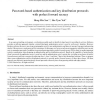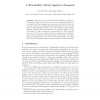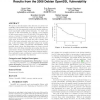63 search results - page 6 / 13 » Protecting Cryptographic Keys from Memory Disclosure Attacks |
SACRYPT
2004
Springer
14 years 20 days ago
2004
Springer
The white box attack context as described in [1, 2] is the common setting where cryptographic software is executed in an untrusted environment—i.e. an attacker has gained access ...
JCSS
2006
13 years 7 months ago
2006
In an open networking environment, a workstation usually needs to identify its legal users for providing its services. Kerberos provides an efficient approach whereby a trusted th...
HOTOS
2003
IEEE
14 years 18 days ago
2003
IEEE
Cerium is a trusted computing architecture that protects a program’s execution from being tampered while the program is running. Cerium uses a physically tamperresistant CPU and...
FC
2010
Springer
13 years 11 months ago
2010
Springer
Since 2004, many nations have started issuing “e-passports” containing an RFID tag that, when powered, broadcasts information. It is claimed that these passports are more secur...
IMC
2009
ACM
14 years 1 months ago
2009
ACM
We report on the aftermath of the discovery of a severe vulnerability in the Debian Linux version of OpenSSL. Systems affected by the bug generated predictable random numbers, mo...



